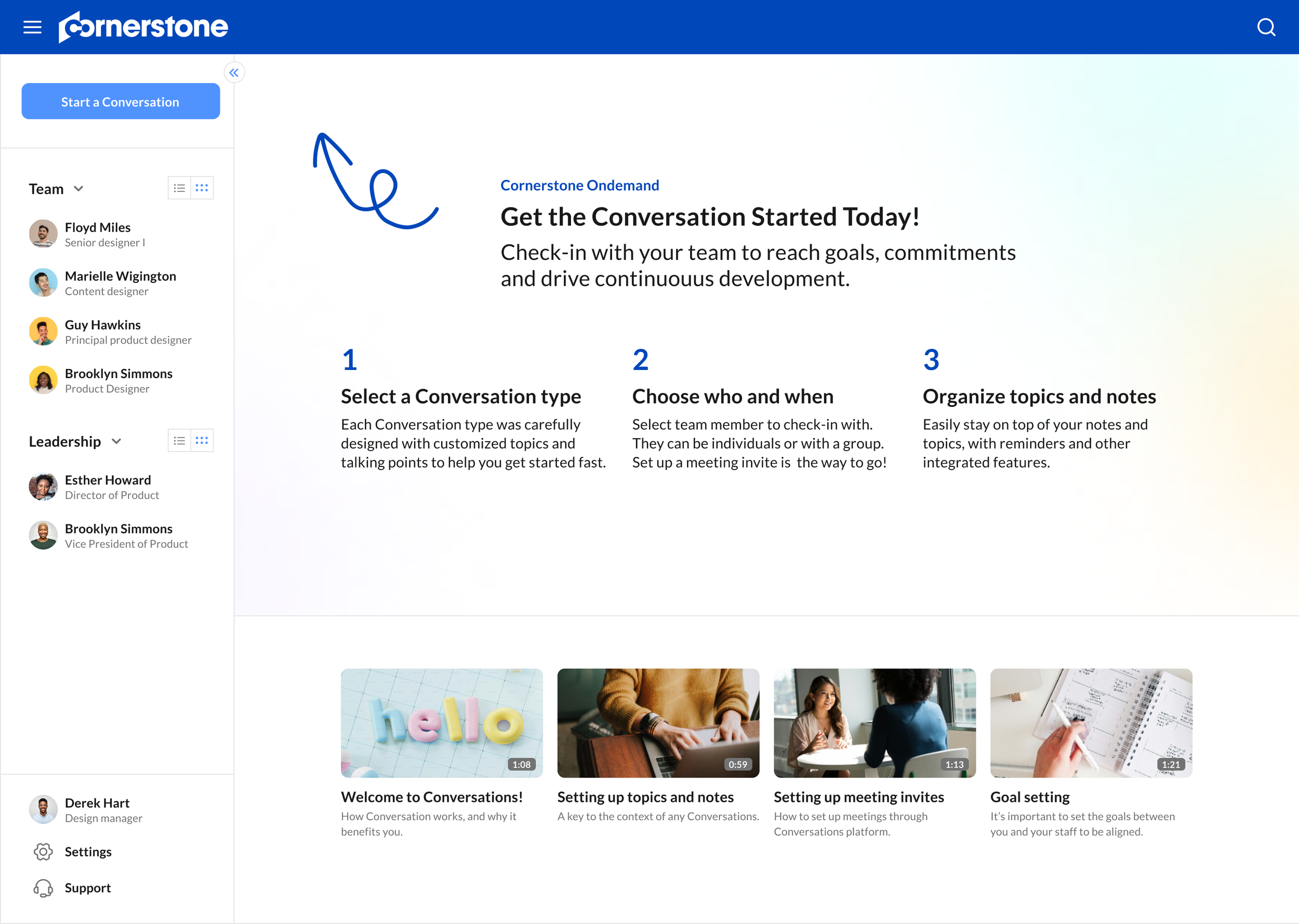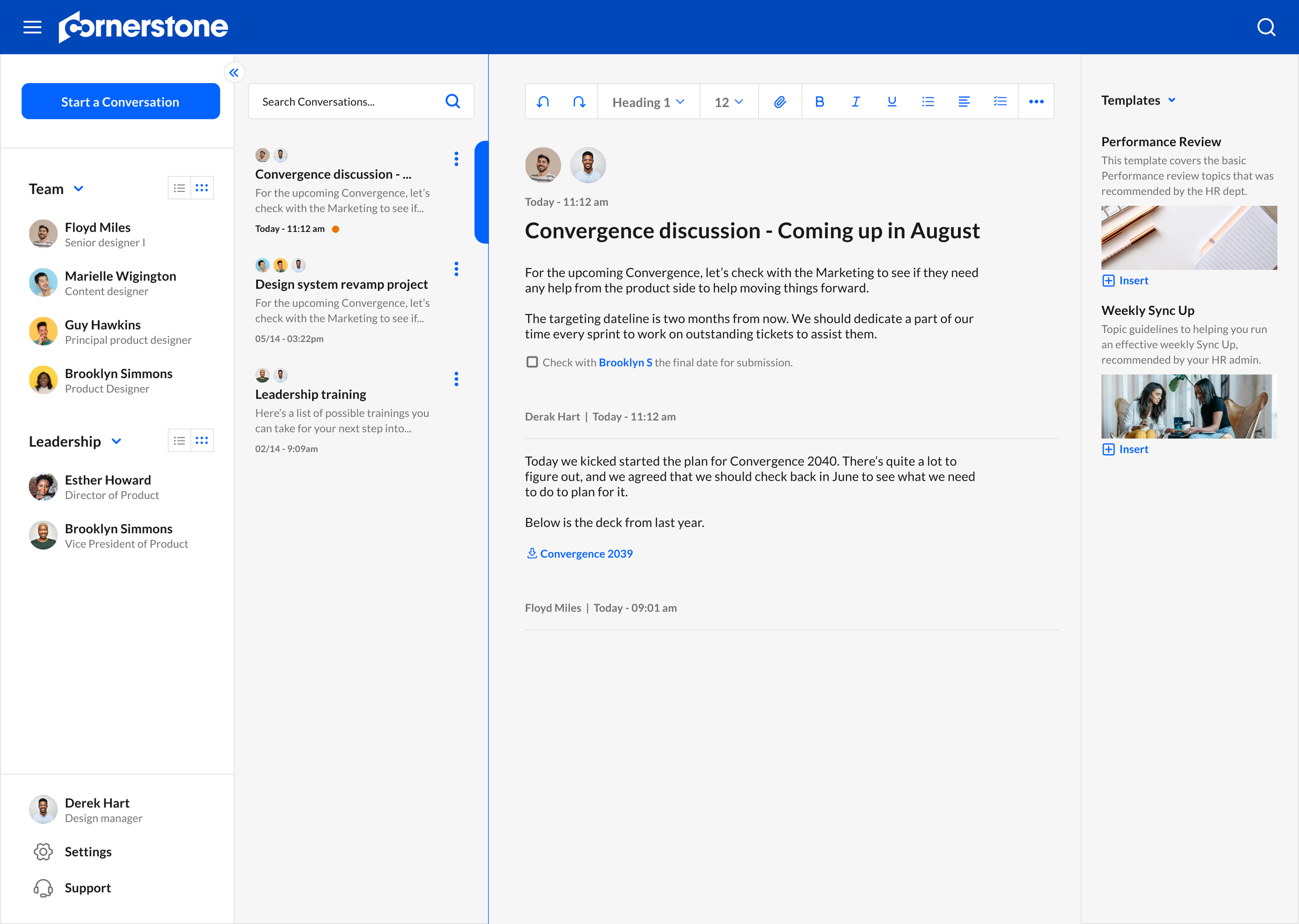
Conversations
An internal tool that helps users track their performance and growth together. It encourages teamwork and interaction by allowing team members to share insights and updates.
Project background
🚀 Project Type: B2B enterprise SaaS product
🎯 Key Outcome: Released MVP of this product, adding new product under the Performance suite.
🧠 Role: Led end-to-end design, collaborated with PM & eng.
📊 Impact: Over 70% of product adoption with Performance product customers
———-
Why was this being asked?
A competition emerged for tools that help organisations track work progress and improve performance, aiming to replace lengthy yearly reviews. The company wanted to launch Conversations early to compete in this area and support its customers.
What does this mean for the customers?
Clients expressed a need for a product that allows better tracking of employee work over the year. The issue was that much progress went undocumented, which was important for companies using self-reported formats for performance reviews.
Problem Statement
“How can we help our users to better track work progress at one place throughout the year?”
Target User
Managers, employees, business administrators
Project Stakeholders
Product Managers
Front-end Engineers
Backend Engineers
Project Timeline
3-6 months
My Role
Product designer
Strategy: A one-week design sprint with an acquired PM and Engineering team in Auckland, New Zealand. I flew-in from the headquarter in the US, and worked with the teams.
With the tight dateline of MVP, the design sprint workshop was performed. The participants were 2 product managers, 3 front-end engineers, 2 backend engineers, and 1 product designer (me).
Day 1: Project overview, user interviews, user journeys and feature brainstorming
We started with understanding what our users want, by interviewing them. We drafted out their current experience and workflow, and brainstormed their needs along the way:
Below sums up their wants with each persona:
HR admins(post MVP):
Ability to provide Conversations guidelines & talking points
Ability to measure engagement frequency between staff
Managers
Ability to track work progress
Ability to sync up quickly & regularly.
Ability to use Conversation templates for guidance.
Employees:
Ability to share work progress
Ability to sync up quickly & regularly.
Ability to self-provide performance review quickly.
Day 2: Brainstorming ideas, researching, presenting ideas to each other.
I had the idea of having the view of immediate team members on the left, and conversations stands in the center as the main content, and supporting templates (such as Goals..etc.) on the right.
Day 3: Participants voted on the ideas, and features that they believe help to solve the customer pain points.
Day 4: With the votes altogether, me and the PM, made the final decisions on the features, and I turned into a wireframes, be ready for testing on Friday.
My designs were voted highly positive, with some integrations ideas from other stakeholders (such as having To-Dos, integrated Topics recommendations tailored from company admins.)
Day 5: We asked questions to our customers about the wireframe.
One key customer feedback was about the logging in and out of when integrated with other products. Design seemed be less of a concern, but more on the workflow side.
After the design sprint, an initial mockup of design was created based on the design sprint workshop.
There happened to be re-org happening plus a new design system initiative within the company. The UIs of the design had to change shortly after.
The old design style was as follow:
From then, design was reintegrated to adapt to newer design system (far right).
Further design exploration and design ↓
Click the play button to open up the prototype, and expand button for the full frame.
———
Key Result: Conversation was adopted by our Performance clients within 6 months at a 75% rate.
What did I learn from this project?
Lots of innovative ideas can come from a design sprint workshop, but it’s important to balance them out with the legistics such as technical resource limitations, and release timeline.
Design must participate early in project development and discussions, as the input can shape the product's direction to provide more value to customers.
Communicating clearly with collaborators can be a great way to create buy-ins and understand each other.











